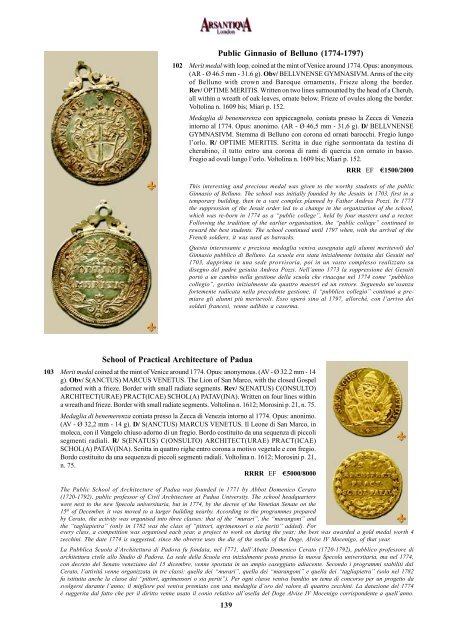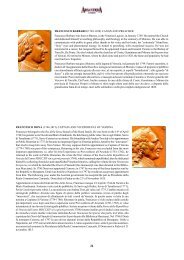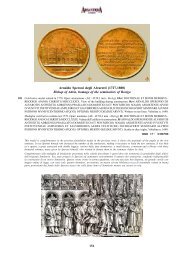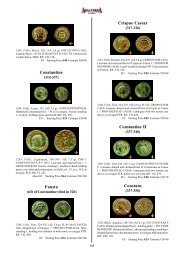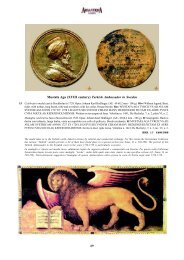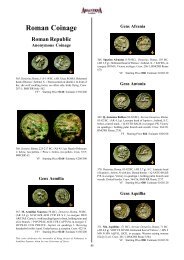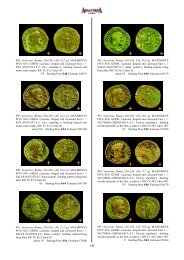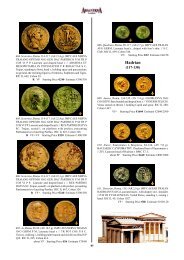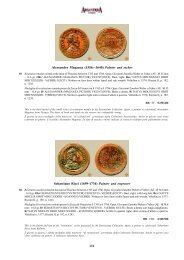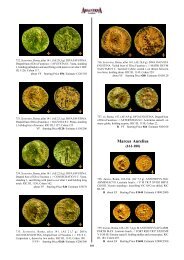Medaglie - Arsantiqva
Medaglie - Arsantiqva
Medaglie - Arsantiqva
You also want an ePaper? Increase the reach of your titles
YUMPU automatically turns print PDFs into web optimized ePapers that Google loves.
Public Ginnasio of Belluno (1774-1797)<br />
102 Merit medal with loop, coined at the mint of Venice around 1774. Opus: anonymous.<br />
(AR - Ø 46.5 mm - 31.6 g). Obv/ BELLVNENSE GYMNASIVM. Arms of the city<br />
of Belluno with crown and Baroque ornaments, Frieze along the border.<br />
Rev/ OPTIME MERITIS. Written on two lines surmounted by the head of a Cherub,<br />
all within a wreath of oak leaves, ornate below. Frieze of ovules along the border.<br />
Voltolina n. 1609 bis; Miari p. 152.<br />
Medaglia di benemerenza con appiccagnolo, coniata presso la Zecca di Venezia<br />
intorno al 1774. Opus: anonimo. (AR - Ø 46,5 mm - 31,6 g). D/ BELLVNENSE<br />
GYMNASIVM. Stemma di Belluno con corona ed ornati barocchi. Fregio lungo<br />
l’orlo. R/ OPTIME MERITIS. Scritta in due righe sormontata da testina di<br />
cherubino, il tutto entro una corona di rami di quercia con ornato in basso.<br />
Fregio ad ovuli lungo l’orlo. Voltolina n. 1609 bis; Miari p. 152.<br />
RRR EF e1500/2000<br />
This interesting and precious medal was given to the worthy students of the public<br />
Ginnasio of Belluno. The school was initially founded by the Jesuits in 1703, first in a<br />
temporary building, then in a vast complex planned by Father Andrea Pozzi. In 1773<br />
the suppression of the Jesuit order led to a change in the organization of the school,<br />
which was re-born in 1774 as a “public college”, held by four masters and a rector.<br />
Following the tradition of the earlier organisation, the “public college” continued to<br />
reward the best students. The school continued until 1797 when, with the arrival of the<br />
French soldiers, it was used as barracks.<br />
Questa interessante e preziosa medaglia veniva assegnata agli alunni meritevoli del<br />
Ginnasio pubblico di Belluno. La scuola era stata inizialmente istituita dai Gesuiti nel<br />
1703, dapprima in una sede provvisoria, poi in un vasto complesso realizzato su<br />
disegno del padre gesuita Andrea Pozzi. Nell’anno 1773 la soppressione dei Gesuiti<br />
portò a un cambio nella gestione della scuola che rinacque nel 1774 come “pubblico<br />
collegio”, gestito inizialmente da quattro maestri ed un rettore. Seguendo un’usanza<br />
fortemente radicata nella precedente gestione, il “pubblico collegio” continuò a premiare<br />
gli alunni più meritevoli. Esso operò sino al 1797, allorché, con l’arrivo dei<br />
soldati francesi, venne adibito a caserma.<br />
School of Practical Architecture of Padua<br />
103 Merit medal coined at the mint of Venice around 1774. Opus: anonymous. (AV - Ø 32.2 mm - 14<br />
g). Obv/ S(ANCTUS) MARCUS VENETUS. The Lion of San Marco, with the closed Gospel<br />
adorned with a frieze. Border with small radiate segments. Rev/ S(ENATUS) C(ONSULTO)<br />
ARCHITECT(URAE) PRACT(ICAE) SCHOL(A) PATAV(INA). Written on four lines within<br />
a wreath and frieze. Border with small radiate segments. Voltolina n. 1612; Morosini p. 21, n. 75.<br />
Medaglia di benemerenza coniata presso la Zecca di Venezia intorno al 1774. Opus: anonimo.<br />
(AV - Ø 32,2 mm - 14 g). D/ S(ANCTUS) MARCUS VENETUS. Il Leone di San Marco, in<br />
moleca, con il Vangelo chiuso adorno di un fregio. Bordo costituito da una sequenza di piccoli<br />
segmenti radiali. R/ S(ENATUS) C(ONSULTO) ARCHITECT(URAE) PRACT(ICAE)<br />
SCHOL(A) PATAV(INA). Scritta in quattro righe entro corona a motivo vegetale e con fregio.<br />
Bordo costituito da una sequenza di piccoli segmenti radiali. Voltolina n. 1612; Morosini p. 21,<br />
n. 75.<br />
RRRR EF e5000/8000<br />
The Public School of Architecture of Padua was founded in 1771 by Abbot Domenico Cerato<br />
(1720-1792), public professor of Civil Architecture at Padua University. The school headquarters<br />
were next to the new Specola universitaria, but in 1774, by the decree of the Venetian Senate on the<br />
15th of December, it was moved to a larger building nearby. According to the programmes prepared<br />
by Cerato, the activity was organised into three classes: that of the “murari”, the “marangoni” and<br />
the “tagliapietra” (only in 1782 was the class of “pittori, agrimensori o sia periti” added). For<br />
every class, a competition was organised each year, a project to work on during the year; the best was awarded a gold medal worth 4<br />
zecchini. The date 1774 is suggested, since the obverse uses the die of the osella of the Doge, Alvise IV Mocenigo, of that year.<br />
La Pubblica Scuola d’Architettura di Padova fu fondata, nel 1771, dall’Abate Domenico Cerato (1720-1792), pubblico professore di<br />
architettura civile allo Studio di Padova. La sede della Scuola era inizialmente posta presso la nuova Specola universitaria, ma nel 1774,<br />
con decreto del Senato veneziano del 15 dicembre, venne spostata in un ampio caseggiato adiacente. Secondo i programmi stabiliti dal<br />
Cerato, l’attività venne organizzata in tre classi: quella dei “murari”, quella dei “marangoni” e quella dei “tagliapietra” (solo nel 1782<br />
fu istituita anche la classe dei “pittori, agrimensori o sia periti”). Per ogni classe veniva bandito un tema di concorso per un progetto da<br />
svolgersi durante l’anno; il migliore poi veniva premiato con una medaglia d’oro del valore di quattro zecchini. La datazione del 1774<br />
è suggerita dal fatto che per il diritto venne usato il conio relativo all’osella del Doge Alvise IV Mocenigo corrispondente a quell’anno.<br />
139
Pietro Gradenigo (1695-1776) Venetian Senator<br />
104 Celebrative medal cast at Florence in 1776. Opus: Giovanni Zanobio Weber or Veber. (AE - Ø 69.9 mm - 134 g). Obv/ PETRUS<br />
GRADONIGO SE(NATOR) VENE(TUS) AET(ATE) AN(NORUM) LXXX - I(OHANNES) WEBER (incuse signature). Bust,<br />
left, with long hair. Ornate cornice. Rev/ HONOS ET VIRTVS - 1776 (in incuse). Honour and Virtue standing facing. Cornice with<br />
slight ornamentation. Voltolina n. 1618 (otherwise unpublished).<br />
Medaglia celebrativa fusa a Firenze nel 1776. Opus: Giovanni Zanobio Weber o Veber. (AE - Ø 69,9 mm - 134 g). D/ PETRUS<br />
GRADONIGO SE(NATOR) VENE(TUS) AET(ATE) AN(NORUM) LXXX - I(OHANNES) WEBER (firma incusa). Busto a<br />
sinistra con lunga capigliatura. Cornice modanata. R/ HONOS ET VIRTVS - 1776 (in incuso). Le due figure allegoriche dell’Onore<br />
e della Virtù stanti di fronte. Cornice con leggera modanatura. Voltolina n. 1618 (altrimenti inedita).<br />
RRR F+ e300/500<br />
This important medal celebrates Pietro Gradenigo, man of letters, politician, and, especially, bibliophile and numismatist. His palace,<br />
at Santa Giustina, ended as a sort of museum that attracted the interest and curiosity of Venetians and foreigners.<br />
Questa importante medaglia celebra la figura di Pietro Gradenigo, letterato, politico ma soprattutto bibliofilo e numismatico veneziano.<br />
Il suo palazzo, a Santa Giustina, finì per diventare una sorta di museo che attirava l’interesse e la curiosità di veneziani e stranieri.<br />
140
Vincenzo Riccati (1707-1775) Theologian and Mathematician<br />
106 Celebrative medal coined at Bologna in 1776. Opus: Filippo Balugani. (AE - Ø<br />
53 mm - 49.5 g). Obv/ VINCENTIVS RICCATVS - F(ILIPPO) BALVGANI.<br />
Bust towards left, with religious robes and cloak. Rev/ MAGNVS VTRAQVE<br />
- MDCCLXXVI. Religion and Science close to each other in the centre. Religion<br />
holding a cross, next to a cippus, on which there is an open book; Science holds<br />
a compass and a setsquare, next to her a globe with star; above, the rayed divine<br />
triangle between clouds. Voltolina n. 1620; Forrer I, p. 120; Noè 1984, p. 66, 80,<br />
104; Noè 1987, fig. 80.<br />
Medaglia celebrativa coniata a Bologna nel 1776. Opus: Filippo Balugani. (AE<br />
- Ø 53 mm - 49,5 g). D/ VINCENTIVS RICCATVS - F(ILIPPO) BALVGANI.<br />
Busto di scorcio verso sinistra con abito talare e mantello. R/ MAGNVS<br />
VTRAQVE - MDCCLXXVI. La Religione e la Scienza stanno accostate al<br />
centro. La Religione regge una croce astile accanto ad un cippo su cui poggia un<br />
libro aperto, la Scienza tiene in mano un compasso ed una squadra ed ha accanto<br />
un globo con stella; in alto il triangolo divino raggiante tra nubi. Voltolina<br />
n. 1620; Forrer I, p. 120; Noè 1984, pp. 66, 80, 104; Noè 1987, fig. 80.<br />
RR EF e400/600<br />
See previous historical note.<br />
Cfr. scheda storica precedente.<br />
Vincenzo Riccati (1707-1775) Theologian and Mathematician<br />
105 Celebrative medal coined at Bologna in 1776. Opus: Filippo Balugani. (AR - Ø<br />
53.8 mm - 59.8 g). Obv/ VINCENTIVS RICCATVS - F(ILIPPO) BALVGANI.<br />
Bust, towards left, with religious robes and cloak. Rev/ MAGNVS VTRAQVE<br />
- MDCCLXXVI. Religion and Science close to each other in the centre. Religion<br />
holding a cross, next to a cippus, on which there is an open book; Science holds<br />
a compass and a setsquare, next to her a globe with star; above, the rayed divine<br />
triangle between clouds. Voltolina n. 1620; Forrer I, p. 120; Noè 1984, pp. 66,<br />
80, 104; Noè 1987, fig. 80.<br />
Medaglia celebrativa coniata a Bologna nel 1776. Opus: Filippo Balugani. (AR<br />
- Ø 53,8 mm - 59,8 g). D/ VINCENTIVS RICCATVS - F(ILIPPO) BALVGANI.<br />
Busto di scorcio verso sinistra con abito talare e mantello. R/ MAGNVS<br />
VTRAQVE - MDCCLXXVI. La Religione e la Scienza stanno accostate al<br />
centro. La Religione regge una croce astile accanto ad un cippo su cui poggia un<br />
libro aperto, la Scienza tiene in mano un compasso ed una squadra ed ha accanto<br />
un globo con stella; in alto il triangolo divino raggiante tra nubi. Voltolina<br />
n. 1620; Forrer I, p. 120; Noè 1984, pp. 66, 80, 104; Noè 1987, fig. 80.<br />
RRR FDC e1500/2000<br />
The medal was made post mortem, in honour of Vincenzo Riccati, probably<br />
commissioned by Giovanni Antonio Pedevilla, his pupil. Examples in silver and<br />
bronze are known. The Serenissima Collection offers two in extraordinary<br />
conservation in different metals; this one, the rarer and more precious one, is in<br />
silver.<br />
La medaglia venne realizzata, post mortem, in onore di Vincenzo Riccati su probabile<br />
commissione di Giovanni Antonio Pedevilla, suo allievo. Sono noti esemplari<br />
in argento e in bronzo. La Collezione Serenissima ne propone due di straordinaria<br />
conservazione in metalli diversi: questo primo, più raro e prezioso, è<br />
realizzato in argento.<br />
141
Cathedral Church of the Santi Apostoli Pietro and Paolo of Adria<br />
107 Foundation medal cast in 1776. Opus: anonymous. (AE - Ø 61.1 mm - 65 g). Obv/ TEMPLVM CATHE(DRALE) SS 1<br />
AP(OSTOLORVM) PETRI ET PAV(LI) PLVRIES REPARATVM A FVNDAMEMTIS RESTITVITVR - ADRIAE A(NNO)<br />
MDCCLXXVI. The façade of the cathedral. Rev/ ARNALDI SPERONI DE ALVAROTIS EPISCOPI ADRIENSIS STVDIO<br />
ORDO CANONICORVM ET CIVES RITE P(ONI) C(VRAVERVNT). Written on seven lines, with frieze below. Voltolina n. 1621.<br />
1 SS stands for SANCTORVM. .<br />
Medaglia di fondazione fusa nel 1776. Opus: anonimo. (AE - Ø 61,1 mm - 65 g). D/ TEMPLVM CATHE(DRALE) SS1 AP(OSTOLORVM) PETRI ET PAV(LI) PLVRIES REPARATVM A FVNDAMEMTIS RESTITVITVR - ADRIAE A(NNO)<br />
MDCCLXXVI. Il prospetto della Cattedrale. R/ ARNALDI SPERONI DE ALVAROTIS EPISCOPI ADRIENSIS STVDIO ORDO<br />
CANONICORVM ET CIVES RITE P(ONI) C(VRAVERVNT). Scritta in sette righe con fregi in basso. Voltolina n. 1621.<br />
RRR Piercing filled with wax. VF e500/800<br />
1 SS sta per SANCTORVM. .<br />
A typical foundation medal is here on offer. The ancient Cathedral of Adria (it had existed since the IX century), dedicated to the Apostles<br />
Pietro and Paolo, had frequent restorations and partial re-buildings. Only in 1776, on the initiative of the Bishop Arnaldo Speroni degli<br />
Alvarotti (see n. 91), was it completely re-built. After levelling, in the same year, Speroni blessed and laid the first stone of the Cathedral,<br />
together with an example of this medal. A series of difficulties delayed the conclusion of the works; at last, on the 22nd of December 1836<br />
Bishop Antonio Maria Calcagno blessed the Cathedral. The façade remained incomplete.<br />
Viene qui proposta una tipica medaglia “di fondazione”. L’antica Cattedrale di Adria (esistente fin dal IX secolo), dedicata agli apostoli<br />
Pietro e Paolo, era stata sottoposta a frequenti interventi di restauro e parziale riedificazione. Solo nel 1776, però, per iniziativa del<br />
Vescovo Arnaldo Speroni degli Alvarotti (cfr. n. 91), fu integralmente riedificata. Dopo imponenti lavori di sbancamento, in quello stesso<br />
anno, lo Speroni benedì e pose nelle fondamenta la prima pietra della Cattedrale assieme a un esemplare della medaglia. Il succedersi<br />
di circostanze avverse ritardò la conclusione dei lavori; infine il 22 dicembre 1836 la Cattedrale fu benedetta dal Vescovo Antonio Maria<br />
Calcagno. La facciata però rimase incompleta.<br />
142
Scuola Grande of Santa Maria della Carità in Venice<br />
108 Celebrative medal coined at the mint of Venice in 1776. Opus: Antonio Schabel. (AR - Ø 40.8 mm - 26.2 g). Obv/ BENIGNA EST<br />
OMNIA SVSTINET - A(NTONIVS) SCHABEL F(ECIT). Female figure representing Charity, seated right, holding baby she is<br />
feeding with her left arm, with her right arm she hugs another child; a third child, on the right, holds the symbol of the Scuola.<br />
Rev/ COLLEGIVM CARITATIS INSTITVTVM VIII ID(VS) NO(VEMBRIS) A(NNO) MCCLX - A(NNO) MDCCLXXVI. A<br />
kneeling man, head covered by a hood, receives a rope with multiple ribbons on the end from a bishop with stole; on the ground,<br />
against a step, the symbol of the Scuola della Carità in a cornice. Voltolina n. 1622 (otherwise unpublished).<br />
Medaglia celebrativa coniata presso la Zecca di Venezia nel 1776. Opus: Antonio Schabel. (AR - Ø 40,8 mm - 26,2 g). D/ BENIGNA<br />
EST OMNIA SVSTINET - A(NTONIVS) SCHABEL F(ECIT). Figura femminile rappresentante la Carità seduta verso destra, con<br />
la sinistra regge un bambino, che sta allattando, e con la destra ne abbraccia un altro; un terzo, sulla destra, esibisce il simbolo della<br />
Scuola. R/ COLLEGIVM CARITATIS INSTITVTVM VIII ID(VS) NO(VEMBRIS)A(NNO) MCCLX - A(NNO) MDCCLXXVI.<br />
Un uomo inginocchiato, il capo coperto da un cappuccio, riceve dalle mani di un Vescovo con mozzetta e stola un cordone con fiocchi<br />
multipli alle estremità; per terra, appoggiato ad uno scalino, il simbolo della Scuola della Carità in cornice. Voltolina n. 1622<br />
(altrimenti inedita).<br />
RRR FDC e1500/2000<br />
Since 1776 the “Zonta” of the Scuola Grande di Santa Maria della Carità, had encouraged the making of annual medals that followed<br />
the criteria of artistic value and uniformity. For this reason they chose Antonio Schabel, the best engraver in the Venetian mint. But this<br />
project was abandoned in the following years; it was only taken up again around the year 1785, with the realisation of a series of great<br />
success, proved by the fact that the Scuola Grande di San Giovanni Evangelista also decided to create a similar series, asking Schabel<br />
to execute it, and jealously keeping series for themselves. The medal here on offer celebrates the foundation of the Scuola at the church<br />
of San Leonardo, on the 6th of November 1260; from there the Confraternita would move, first to the Oratorio di San Giacomo alla<br />
Giudecca, then (around 1287) in the Lateranense Monastery, next to the church of the Carità. At last, in 1344, part of the Monastery was<br />
bought, and permanent headquarters were built. As well as its interest as a medal from the Venetian Scuole Grandi, there is also the fact<br />
that this on offer is the first of a series of great prestige.<br />
Fin dal 1776 la “Zonta” della Scuola Grande di Santa Maria della Carità aveva incoraggiato la realizzazione di medaglie annuali che<br />
rispondessero a criteri prestabiliti di uniformità e validità artistica. Per questo era stato scelto appunto Antonio Schabel, il più abile<br />
incisore della Zecca di Venezia. Di fatto, però, negli anni seguenti il progetto venne accantonato. Fu ripreso solo intorno al 1785, con<br />
la realizzazione di una serie che ottenne uno straordinario successo. Lo dimostra il fatto che, poco dopo, anche la Scuola Grande di San<br />
Giovanni Evangelista volle dar vita a una serie simile, affidandone la realizzazione allo stesso Schabel e imponendo la gelosa conser<br />
vazione della “raccolta”. La medaglia qui proposta ricorda la fondazione della Scuola avvenuta nella Chiesa di San Leonardo il 6<br />
novembre 1260; da qui poi la Confraternita si sarebbe spostata, dapprima presso l’Oratorio di San Giacomo alla Giudecca, poi (verso<br />
il 1287) nel Monastero lateranense attiguo alla Chiesa della Carità. Infine, nel 1344, acquisita una parte del Monastero, venne iniziata<br />
la costruzione di una sede pienamente autonoma. All’interesse suscitato dalle medaglie delle Scuole Grandi veneziane si aggiunge<br />
quindi il fatto che quella qui offerta è la prima di una serie di grande prestigio.<br />
143
109<br />
To Jacopo Gradenigo<br />
(1721- post 1796)<br />
Provveditore Generale of Dalmatia and Albania<br />
Celebrative medal with ornate loop, coined at Bologna in 1777.<br />
Opus: Filippo Balugani. (Gilded AR - Ø 66.9 mm - 89.2 g).<br />
Obv/ IACOBO GRADONICO PROCONSVLI PATRI SVO -<br />
F(ILIPPO) BALVGANI. Bust, left, with ornate robe, cloak and<br />
hair with ribbon behind the neck. Ornate cornice. Rev/ GENIVS<br />
OBSEQVENS EXERCITVS ILLYRII - A(NNO) S(ALVTIS)<br />
MDCCLXXVII SVI PROCONSVLATVS TERTIO. In the centre,<br />
a Tyche, Goddess of prosperity, turned left, with a bushel on her<br />
head and a cloak on her shoulders, holding a cornucopia from<br />
which coins pour. At right, two standards, the first with the Lion<br />
of San Marco; at left, three flags, the first with the Lion of San<br />
Marco with a sword; under, the arms of Gradenigo. Ornate cornice.<br />
Voltolina n. 1625; Correr sec. XVII-XVIII, p. 109, n. 96; Forrer<br />
I, p. 120; Majer 1929, p. 9; Noè 1984, p. 80-81, fig. 81, p. 104,<br />
n. 23.<br />
Medaglia celebrativa con appiccagnolo ornato, coniata a Bologna<br />
nel 1777. Opus: Filippo Balugani. (AR dorato - Ø 66,9 mm - 89,2<br />
g). D/ IACOBO GRADONICO PROCONSVLI PATRI SVO -<br />
F(ILIPPO) BALVGANI. Busto a sinistra con abito ornato, mantello<br />
e nastro ai capelli dietro il collo. Cornice modanata. R/ GENIVS<br />
OBSEQVENS EXERCITVS ILLYRII - A(NNO) S(ALVTIS)<br />
MDCCLXXVII SVI PROCONSVLATVS TERTIO. Nel centro<br />
Tyche, la dea della prosperità – volta a sinistra, con sulla testa un<br />
moggio e sulle spalle un mantello – in atto di reggere una cornucopia<br />
rovesciata dalla quale sgorgano monete. A destra due stendardi, il<br />
primo con il Leone di San Marco; a sinistra tre bandiere, sulla<br />
prima il Leone di San Marco con spada, sotto, lo stemma Gradenigo.<br />
Cornice modanata. Voltolina n. 1625; Correr sec. XVII-XVIII, p.<br />
109, n. 96; Forrer I, p. 120; Majer 1929, p. 9; Noè 1984, pp. 80-<br />
81, fig. 81, p. 104, n. 23.<br />
RRRRR FDC e2200/3000<br />
After having met Pietro Gradenigo (see n. 104), here we have his<br />
nephew Jacopo. This medal was given to him early in 1777, by the<br />
citizens of Illyria, at the end of his mandate as Provveditore Generale<br />
of Dalmatia and Albania. As well as helping the inhabitants with<br />
works of public utility, he acted in defeating the bandits<br />
and criminals that roamed the villages and countryside and brought<br />
back discipline in the army. These actions are mentioned in this<br />
refined medal through the iconography and the legend on the reverse.<br />
The Serenissima Collection offers three versions of this medal,<br />
different in the metal or presence of a loop. The first medal here on<br />
offer is really extraordinary: the gilding does not hide the silver<br />
underneath, and there is an elegant loop that makes it wearable.<br />
These characteristics can let us suppose that it was the example given<br />
to Gradenigo, since we have no information about a gold example<br />
of this medal.<br />
Dopo aver incontrato Pietro Gradenigo (cfr. n. 104), ritroviamo qui suo nipote Jacopo. Questa medaglia gli venne assegnata, nei primi<br />
mesi del 1777, dai sudditi dell’Illirico al termine del suo mandato di Provveditore Generale di Dalmazia e Albania. Oltre a soccorrere gli<br />
abitanti con opere di pubblica utilità, egli si era impegnato a debellare banditi e malviventi che infestavano borghi e campagne e a<br />
riportare la disciplina nell’esercito. Tali aspetti sono ricordati in questa raffinata medaglia sia attraverso l’iconografia che il motto del<br />
rovescio. La Collezione Serenissima propone tre esemplari di questa medaglia diversi per metallo o per la presenza di appiccagnolo.<br />
Quello che viene qui proposto per primo è davvero straordinario: la doratura che lo caratterizza non impedisce di vedere l’argento<br />
sottostante, da cui è costituito; inoltre è presente un elegante appiccagnolo che lo rende portativo. Tali caratteristiche fanno ritenere che<br />
si tratti dell’esemplare offerto al Gradenigo stesso, tanto più che non abbiamo alcuna notizia dell’esistenza di un’eventuale versione in oro<br />
della medaglia.<br />
144
To Jacopo Gradenigo (1721- post 1796)<br />
Provveditore Generale of Dalmatia and Albania<br />
110 Celebrative medal coined at Bologna in 1777. Opus: Filippo Balugani. (AR - Ø 67.2 mm - 79.8 g). Obv/ IACOBO GRADONICO<br />
PROCONSVLI PATRI SVO - F(ILIPPO) BALVGANI. Bust, left, with ornate robe, cloak and hair with ribbon behind the neck.<br />
Decorated cornice. Rev/ GENIVS OBSEQVENS EXERCITVS ILLYRII - A(NNO) S(ALVTIS) MDCCLXXVII SVI<br />
PROCONSVLATVS TERTIO. In the centre, a Tyche, Goddess of prosperity, turned left, with a bushel on her head and a cloak on<br />
her shoulders, holding a cornucopia from which coins pour:At right, two standards, the first with the Lion of San Marco; at left, three<br />
flags, the first with the Lion of San Marco with a sword, below, the arms of Gradenigo. Ornate cornice. Voltolina n. 1625; Correr<br />
sec. XVII-XVIII, p. 109, n. 96; Forrer I, p. 120; Majer 1929, p. 9; Noè 1984, p. 80-81, fig. 81, p. 104, n. 23.<br />
Medaglia celebrativa coniata a Bologna nel 1777. Opus: Filippo Balugani. (AR - Ø 67,2 mm - 79,8 g). D/ IACOBO GRADONICO<br />
PROCONSVLI PATRI SVO - F(ILIPPO) BALVGANI. Busto a sinistra con abito ornato, mantello e nastro ai capelli dietro il collo.<br />
Cornice modanata. R/ GENIVS OBSEQVENS EXERCITVS ILLYRII - A(NNO) S(ALVTIS) MDCCLXXVII SVI<br />
PROCONSVLATVS TERTIO. Nel centro Tyche, la dea della prosperità - volta a sinistra, con sulla testa un moggio e sulle spalle un<br />
mantello - in atto di reggere una cornucopia rovesciata dalla quale sgorgano monete. A destra due stendardi, il primo con il Leone di<br />
San Marco; a sinistra tre bandiere, sulla prima il Leone di San Marco con spada, sotto, lo stemma Gradenigo. Cornice modanata.<br />
Voltolina n. 1625; Correr sec. XVII-XVIII, p. 109, n. 96; Forrer I, p. 120; Majer 1929, p. 9; Noè 1984, pp. 80-81, fig. 81, p. 104,<br />
n. 23.<br />
RRRR FDC e2000/2500<br />
Only a large collection like the Serenissima Collection can offer two different examples in silver of this extremely rare and extraordinary<br />
medal of Gradenigo. The conservation is exceptional.<br />
Solo una grande raccolta come la Collezione Serenissima può permettersi di offrire due diversi esemplari in argento di questa rarissima<br />
e straordinaria medaglia del Gradenigo. La conservazione è eccezionale.<br />
See previous historical note.<br />
Cfr. scheda storica precedente.<br />
145
To Jacopo Gradenigo (1721- post 1796)<br />
Provveditore Generale of Dalmatia and Albania<br />
111 Celebrative medal coined at Bologna in 1777. Opus: Filippo Balugani. (AE - Ø 67.8 mm - 132 g). Obv/ IACOBO GRADONICO<br />
PROCONSVLI PATRI SVO - F(ILIPPO) BALVGANI. Bust, left, with ornate robe, cloak and hair with ribbon behind the neck.<br />
Decorated cornice. Rev/ GENIVS OBSEQVENS EXERCITVS ILLYRII - A(NNO) S(ALVTIS) MDCCLXXVII SVI<br />
PROCONSVLATVS TERTIO. In the centre, a Tyche, Goddess of prosperity, turned left, with a bushel on her head and a cloak on<br />
her shoulders, holding a cornucopia from which coins pour:At right, two standards, the first with the Lion of San Marco; at left, three<br />
flags, the first with the Lion of San Marco with a sword, below, the arms of Gradenigo. Ornate cornice. Voltolina n. 1625; Correr sec.<br />
XVII-XVIII, p. 109, n. 96; Forrer I, p. 120; Majer 1929, p. 9; Noè 1984, p. 80-81, fig. 81, p. 104, n. 23.<br />
Medaglia celebrativa coniata a Bologna nel 1777. Opus: Filippo Balugani. (AE - Ø 67,8 mm - 132 g). D/ IACOBO GRADONICO<br />
PROCONSVLI PATRI SVO - F(ILIPPO) BALVGANI. Busto a sinistra con abito ornato, mantello e nastro ai capelli dietro il collo.<br />
Cornice modanata. R/ GENIVS OBSEQVENS EXERCITVS ILLYRII - A(NNO) S(ALVTIS) MDCCLXXVII SVI<br />
PROCONSVLATVS TERTIO. Nel centro Tyche, la dea della prosperità – volta a sinistra, con sulla testa un moggio e sulle spalle un<br />
mantello – in atto di reggere una cornucopia rovesciata dalla quale sgorgano monete. A destra due stendardi, il primo con il Leone di<br />
San Marco; a sinistra tre bandiere, sulla prima il Leone di San Marco con spada, sotto, lo stemma Gradenigo. Cornice modanata.<br />
Voltolina n. 1625; Correr sec. XVII-XVIII, p. 109, n. 96; Forrer I, p. 120; Majer 1929, p. 9; Noè 1984, pp. 80-81, fig. 81, p. 104,<br />
n. 23.<br />
RRR EF e600/800<br />
Ex Isaia Volonté Collection.<br />
See previous historical note.<br />
Cfr. scheda storica precedente.<br />
146
Urbano Savorgnan (1704-1777) Filippino Father and collector<br />
112 Celebrative medal with loop, coined at Bologna around 1777. Opus: Francesco Corazzini. (AR-Ø65mm-111g).Obv/ VRBANO<br />
SAVORGNANO PATRIT(IO) VEN(ETO) P(RES)B(YTE)RO ORAT(ORII) BONON(IENSIS) - FRAN(CISCVS) CORAZZINI<br />
F(ECIT). Bust, right, with religious robe and cloak. Rev/ SVPELL(ECTILIBVS) CONLAT(IS) AD INCREM(ENTVM)<br />
SCIENT(IARVM) ET ART(IVM) - SENAT(ORES) PRAEF(ECTI) INSTIT(VTO) V(IRO) B(ENE) M(ERENTI) D(ANT)<br />
D(EDICANT). Written partly on three central lines, within an oak and laurel wreath, and part around. Voltolina n. 1627; Forrer I,<br />
p. 458; Johnson 1990, II, n. 282; Savio p. 114, n. 34.<br />
Medaglia celebrativa con appiccagnolo, coniata a Bologna intorno al 1777. Opus: Francesco Corazzini. (AR-Ø65mm-111g).<br />
D/ VRBANO SAVORGNANO PATRIT(IO) VEN(ETO) P(RES)B(YTE)RO ORAT(ORII) BONON(IENSIS) - FRAN(CISCVS)<br />
CORAZZINI F(ECIT). Busto a destra in veste talare e con mantello. R/ SVPELL(ECTILIBVS) CONLAT(IS) AD<br />
INCREM(ENTVM) SCIENT(IARVM) ET ART(IVM) - SENAT(ORES) PRAEF(ECTI) INSTIT(VTO) V(IRO) B(ENE)<br />
M(ERENTI) D(ANT) D(EDICANT). Scritta parte su tre righe al centro, entro corona di foglie di quercia e d’alloro, e parte all’ingiro.<br />
Voltolina n. 1627; Forrer I, p. 458; Johnson 1990, II, n. 282; Savio p. 114, n. 34.<br />
RRR EF e1800/3000<br />
Urbano Maria Savorgnan, Filippino Father and proprietor of a rich medal “museum”, died in Bologna in 1777. In his will the collection<br />
was left to the city’s Institute of Science and Arts. On the 26th of August 1777, as a mark of gratitude, the Senators of the Institute voted<br />
that the Savorgnan family should be accepted into the nobility of Bologna and that a large silver medal be made to “send it each year<br />
in gift”. The Serenissima Collection is able to produce two examples of the medal in different metals. The first, particularly precious one,<br />
is in silver and has a rich loop that makes it wearable.<br />
Nel 1777 moriva a Bologna Urbano Maria Savorgnan, Padre filippino ma anche proprietario di un ricco “museo” di medaglie. Per<br />
disposizione testamentaria tale collezione veniva donata all’Istituto delle Scienze ed Arti della città. Il 26 agosto 1777, in segno di<br />
riconoscenza, i Senatori preposti all’Istituto disponevano solennemente che la famiglia Savorgnan venisse accolta nella nobiltà bolognese<br />
e che venisse realizzata una “grossa medaglia d’argento” da “mandarle ciascun anno in dono”. La Collezione Serenissima è in<br />
grado di proporre due esemplari della medaglia in diversi metalli. Questo primo, particolarmente prezioso, realizzato in argento, è<br />
corredato di un ricco appiccagnolo che lo rende portativo.<br />
147
Urbano Savorgnan (1704-1777) Filippino Father and collector<br />
113 Celebrative medal coined at Bologna around 1777. Opus: Francesco Corazzini. (AE-Ø65mm-89g).Obv/ VRBANO SAVORGNANO<br />
PATRIT(IO) VEN(ETO) P(RES)B(YTE)RO ORAT(ORII) BONON(IENSIS) - FRAN(CISCVS) CORAZZINI F(ECIT). Bust,<br />
right, with religious robe and cloak. Rev/ SVPELL(ECTILIBVS) CONLAT(IS) AD INCREM(ENTVM) SCIENT(IARVM) ET<br />
ART(IVM) - SENAT(ORES) PRAEF(ECTI) INSTIT(VTO) V(IRO) B(ENE) M(ERENTI) D(ANT) D(EDICANT). Written<br />
partly on three central lines, within an oak and laurel wreath, and part around. Voltolina n. 1627; Forrer I, p. 458; Johnson 1990, II,<br />
n. 282; Savio p. 114, n. 34.<br />
Medaglia celebrativa coniata a Bologna intorno al 1777. Opus: Francesco Corazzini. (AE -Ø65mm-89g).D/ VRBANO<br />
SAVORGNANO PATRIT(IO) VEN(ETO) P(RES)B(YTE)RO ORAT(ORII) BONON(IENSIS) - FRAN(CISCVS) CORAZZINI<br />
F(ECIT). Busto a destra in veste talare e con mantello. R/ SVPELL(ECTILIBVS) CONLAT(IS) AD INCREM(ENTVM)<br />
SCIENT(IARVM) ET ART(IVM) - SENAT(ORES) PRAEF(ECTI) INSTIT(VTO) V(IRO) B(ENE) M(ERENTI) D(ANT)<br />
D(EDICANT). Scritta parte su tre righe al centro, entro corona di foglie di quercia e d’alloro, e parte all’ingiro. Voltolina n. 1627;<br />
Forrer I, p. 458; Johnson 1990, II, n. 282; Savio p. 114, n. 34.<br />
RR FDC e800/1200<br />
See previous historical note.<br />
Cfr. scheda storica precedente.<br />
148
149<br />
114<br />
Urbano Savorgnan (1704-1777)<br />
Filippino Father and collector<br />
Celebrative medal cast at Bologna in 1777. Opus:<br />
Filippo Scandellari. (AE -Ø93mm-243g).<br />
Obv/ URBANUS SAVORGNAN(US) NOB(ILIS)<br />
VEN(ETUS) PRESB(YTER) ORAT(ORII)<br />
BON(ONIENSIS) ANTIQUIT(ATIS) ET<br />
C(ETERA) ET C(ETERA) AMATOR - F(ILIPPO)<br />
SCANDELARI A[?].Bust, right, with religious robe<br />
and cloak. Rev/ BENEDIC DEUS ME ET MULTA<br />
UNIVERSI GENERA QUAE SERVO. Savorgnan,<br />
kneeling, turned towards God, blessing from a cloud;<br />
in the sky an eagle is flying. Next to Savorgnan there<br />
is Nature (Artemide Efesia), resting on a column, a<br />
cornucopia and a lion; sea in the background with<br />
some ships. Voltolina n. 1628; Johnson 1990, II, n.<br />
484; Noè 1984, p. 89, fig. 95, p. 108, n. 35.<br />
Medaglia celebrativa fusa a Bologna nel 1777. Opus:<br />
Filippo Scandellari. (AE -Ø93mm-243g).<br />
D/ URBANUS SAVORGNAN(US) NOB(ILIS)<br />
VEN(ETUS) PRESB(YTER) ORAT(ORII)<br />
BON(ONIENSIS) ANTIQUIT(ATIS) ET<br />
C(ETERA) ET C(ETERA) AMATOR - F(ILIPPO)<br />
SCANDELARI A[?]. Busto a destra in veste talare e<br />
con mantello. R/ BENEDIC DEUS ME ET MULTA<br />
UNIVERSI GENERAQUAE SERVO. Il Savorgnan,<br />
inginocchiato, è rivolto verso Dio benedicente da una<br />
nube; nel cielo vola un’aquila. Presso al Savorgnan<br />
stanno la figura della Natura (Artemide Efesia), appoggiata<br />
ad una colonna, una cornucopia e un leone;<br />
sullo sfondo marino veleggiano alcune barche.<br />
Voltolina n. 1628; Johnson 1990, II, n. 484; Noè<br />
1984, p. 89, fig. 95, p. 108, n. 35.<br />
RRRR EF e1400/2000<br />
This extremely rare medal, with an unusually large,<br />
was made in Bologna on the occasion of the death of<br />
Savorgnan, to celebrate his merits as a noble Venetian,<br />
a man of religion and passionate lover of art. The<br />
careful collector cannot afford to lose the exceptional<br />
opportunity of finding both medals dedicated to this<br />
personality in the Serenissima Collection.<br />
Questa rarissima medaglia di modulo straordinario<br />
venne realizzata a Bologna, in occasione della morte<br />
del Savorgnan, per celebrarne i meriti legati alla sua<br />
condizione di nobile veneziano, di religioso e di appassionato<br />
cultore dell’arte del passato. Al collezionista<br />
avveduto non può sfuggire l’eccezionalità di trovare<br />
riunite nella Collezione Serenissima le due meda<br />
glie dedicate a questo personaggio.
Scuola Grande of San Rocco in Venice<br />
115 Celebrative medal with ornate loop, cast at Venice in 1778. Opus: anonymous. (AR with cornice and loop in OT - Ø 56.6 mm - 51<br />
g). Obv/ 1778. San Rocco, kneeling, with his right arm distended towards the traditional dog, crouched at left, and a tree; with his left<br />
arm he is holding the pilgrim’s staff with hat. Rev/ Without inscription. San Marco, seated, with closed Gospel resting on his left<br />
knee; in his right, a knife.<br />
Medaglia celebrativa con ricco appiccagnolo ornato, fusa a Venezia nel 1778. Opus: anonimo. (AR con cornice e appiccagnolo in OT<br />
- Ø 56,6 mm - 51 g). D/ 1778. San Rocco, in ginocchio, con il braccio destro disteso verso il tradizionale cane, accovacciato a sinistra,<br />
e un alberello. Con il braccio sinistro regge il bastone da viandante, in cima al quale è il cappello. R/ Anepigrafe. San Marco, seduto,<br />
con il Vangelo chiuso poggiato sulla gamba sinistra; nella destra, un coltello.<br />
RRRR EF e2000/3000<br />
This extraordinary, unpublished, example here on offer is one of the most sought after medals from the Scuole Grandi of Venice. The date,<br />
under the figure of San Rocco, can make us suppose that the medal was ordered by Tommaso Gardin, Guardian Grande of the Scuola<br />
of San Rocco, in the year 1778. The figure of San Marco on the reverse is mysterious and disquieting, with the closed Gospel (normally<br />
open on the phrase that inspires peace), and, instead of the usual pen, is brandishing a knife in an aggressive way. Possibly the medal<br />
refers to a situation of hostility that involved Venice in 1778; less probably it refers to rivalry between the Scuola of San Rocco and that<br />
of San Marco. The iconography is unique in the history of Venetian medals.<br />
Lo straordinario esemplare inedito che viene qui proposto è uno dei pezzi più accattivanti dell’ambita serie di medaglie legate alle Scuole<br />
Grandi di Venezia. La presenza della datazione sotto l’immagine di San Rocco autorizza a identificare il committente in Tommaso<br />
Gardin, Guardian Grande della Scuola di San Rocco in carica nel 1778. Misteriosa e inquietante, sul rovescio, la presenza di San Marco<br />
che, chiuso il Vangelo (normalmente aperto sulla frase ispirata alla pace), brandisce minaccioso un coltello in luogo della penna. È<br />
possibile che la medaglia alluda a una situazione di ostilità che coinvolse Venezia nel 1778; meno probabile che si riferisca a una rivalità<br />
della Scuola di San Rocco con quella di San Marco. Comunque sia si tratta di una situazione iconograficamente unica nella storia della<br />
medaglistica veneziana.<br />
150
Paolo Renier (1779-1789) CXIX Doge<br />
116 Celebrative medal cast at Venice around 1779. Opus: anonymous. (AE - Ø 97.3x75.5 mm - 185 g). Obv/ Without inscription. Bust<br />
of the Doge, three quarter view, with ermine cloak and Doge’s horn. Rev/ Smooth. Voltolina n. 1635 (otherwise unpublished).<br />
Medaglia celebrativa fusa a Venezia intorno al 1779. Opus: anonimo. (AE - Ø 97,3 x 75,5 mm - 185 g). D/ Anepigrafe. Busto del<br />
Doge di tre quarti con mantello di ermellino e corno dogale. R/ Liscio. Voltolina n. 1635 (altrimenti inedita).<br />
RR EF e300/500<br />
This portrait of the Doge Renier is extremely interesting. The absence of a legend makes the collocation problematic; it is possible that<br />
it is an act of homage towards the Doge, but the Doge himself may have had it made, to give it as a keepsake to someone dear.<br />
Decisamente particolare questa suggestiva rappresentazione del Doge Renier. L’assenza di una legenda ne rende problematica la<br />
collocazione. È possibile che essa rappresenti un atto di omaggio nei confronti del Doge, ma non si può escludere che lo stesso Doge<br />
l’avesse destinata a qualche persona cara, come personalissimo ricordo.<br />
151
Medal obtained from a silver bull of the<br />
Doge Paolo Renier (1779-1789)<br />
117 Celebrative medal with loop, coined at the mint of Venice around 1779. Opus: anonymous.<br />
(GildedAR - Ø 38.2 mm-7g).Obv/ S(ANCTVS) M(ARCVS) VENET(VS) PAVL(VS)<br />
RAINERIVS DVX. On the left, haloed San Marco standing and blessing, receiving the<br />
homage of the Doge on the right, wearing Doge’s robe and horn, holding in his right hand<br />
a long pole with a cross. Dotted border. Rev/ PAULUS RAINERIUS DEI GRA(TIA)<br />
DVX VENETIAR(VM) ET C(ETERA). Written on five lines; above, Doge’s horn<br />
between two rosettes. Dotted border. Voltolina n. 1636; Cecchetti.<br />
Medaglia celebrativa con appiccagnolo, coniata presso la Zecca di Venezia intorno al<br />
1779. Opus: anonimo. (AR dorato - Ø 38,2 mm -7g).D/ S(ANCTVS) M(ARCVS)<br />
VENET(VS) PAVL(VS) RAINERIVS DVX. Sulla sinistra San Marco, in piedi con<br />
aureola e in atto benedicente, riceve l’omaggio del Doge; questi, posto sulla destra con<br />
veste e corno dogali, tiene con la destra una lunga asta con la Croce; bordo perlinato.<br />
R/ PAULUS RAINERIUS DEI GRA(TIA) DVX VENETIAR(VM) ET C(ETERA).<br />
Scritta in cinque righe; in alto corno dogale tra due rosette; bordo perlinato. Voltolina<br />
n. 1636; Cecchetti.<br />
RRRR EF e1200/1500<br />
Another medal (see n. 116) intended to celebrate the Doge in a general way; while the<br />
previous one had a detailed portrait of Renier, this one is much more indefinite and offers<br />
a stereotype of the Doge. It was made by re-using a silver bull of the Doge. The effect of this<br />
operation is unusual and pleasing.<br />
Ancora una medaglia (cfr. n. 116) destinata a celebrare in termini estremamente generici<br />
la figura del Doge; mentre la precedente però riproduceva in modo particolareggiato le<br />
fattezze del Renier, questa è decisamente più indefinita e offre un’immagine stereotipata del<br />
personaggio. Del resto essa è stata ottenuta con il riutilizzo di una bolla d’argento del Doge<br />
stesso. L’effetto di questa operazione davvero insolita, è molto originale e gradevole.<br />
Alessandro Antonio Barzizza (1747-1815)<br />
Podestà and Vice captain of Bergamo<br />
118 Celebrative medal coined in 1779. Opus: Francesco Corazzini. (AE - Ø 43.3 mm -<br />
24.8 g). Obv/ ALEX(ANDRO) ANT(ONIO) BARZIZA PRAET(ORI)<br />
PROPRAEF(ECTO) - F(RANCISCVS) CORAZZINI F(ECIT). Bust, left. Rev/ OB<br />
CIVES SERVATOS ARMORVM INTERDICTO BERGOMATES 1779. Written on<br />
six lines within a wreath. Voltolina n. 1638; Johnson 1990, n. 280.<br />
Medaglia celebrativa coniata nel 1779. Opus: Francesco Corazzini. (AE - Ø 43,3 mm<br />
- 24,8 g). D/ ALEX(ANDRO) ANT(ONIO) BARZIZA PRAET(ORI)<br />
PROPRAEF(ECTO) - F(RANCISCVS) CORAZZINI F(ECIT). Busto a sinistra.<br />
R/ OB CIVES SERVATOS ARMORVM INTERDICTO BERGOMATES 1779. Scritta<br />
in sei righe entro corona di foglie. Voltolina n. 1638; Johnson 1990, n. 280.<br />
RR FDC e500/800<br />
Alessandro Antonio Barzizza was elected Podestà of Bergamo on the 13th of November<br />
1777. His mandate started on the 26th of May 1778 and ended on the 25th of September<br />
1779. He arrived in a society with grave social tensions and crime; he undertook an<br />
efficient action of control and prevention, prohibiting the population from walking<br />
around armed. In this way he brought peace and security to Bergamo, and earned the<br />
gratitude of the local population. They dedicated poetical compositions and speeches to<br />
him, and when he left they offered him an example of this medal (probably in gold) here<br />
on offer.<br />
Alessandro Antonio Barzizza fu eletto Podestà di Bergamo il 13 novembre 1777. Il suo<br />
mandato iniziò il 26 maggio 1778 e si concluse il 25 settembre 1779. Giunto in un<br />
ambiente percorso da gravi tensioni sociali e tormentato dalla criminalità, egli svolse<br />
un’efficace azione di controllo e prevenzione impedendo alla popolazione di circolare<br />
armata. Garantì così al Bergamasco pace e sicurezza e guadagnò la stima e la riconoscenza<br />
degli abitanti. Costoro gli dedicarono composizioni poetiche e discorsi e gli<br />
offrirono, al momento della partenza, un esemplare (verosimilmente in oro) della medaglia<br />
qui proposta.<br />
152
Arnaldo Speroni degli Alvarotti (1727-1800)<br />
Bishop of Adria, new Seminary of Rovigo<br />
119 Foundation medal cast in 1779. Opus: anonymous. (AE -Ø76mm-207g).Obv/ ELEGI LOCVM ISTVM VT PERMANEAT<br />
COR MEVM IBI CVNCTIS DIEBVS PARALIP(OMENA) II VII A(NNO) S(ALVTIS) MDCCLXXIX. Three-quarter bust in<br />
high relief, wearing ecclesiastical robes with cross. Ornate cornice. Rev/ ARNALDO SPERONIO DE ALVAROTIS ADRIEN(SI)<br />
PONTIFICI AVSPICI ET SOSPITI SVO AD HAS S(AN)C(TE) INAVGVRATAS AEDES PRIMVM PONENTI LAPIDEM<br />
SACRI EARVMD(EM) SODALES ET ALVMNI GRATI ANIMI ERGO PP 1 . Written on nine lines, with decoration below. Ornate<br />
cornice. Voltolina n. 1639.<br />
1 PP stands for POSVERVNT.<br />
Medaglia di fondazione fusa nel 1779. Opus: anonimo. (AE -Ø76mm-207g).D/ ELEGI LOCVM ISTVM VT PERMANEAT<br />
COR MEVM IBI CVNCTIS DIEBVS PARALIP(OMENA) II VII A(NNO) S(ALVTIS) MDCCLXXIX. Busto di tre quarti in<br />
altorilievo in veste ecclesiastica con croce pettorale. Cornice modanata. R/ARNALDO SPERONIO DE ALVAROTIS ADRIEN(SI)<br />
PONTIFICI AVSPICI ET SOSPITI SVO AD HAS S(AN)C(TE) INAVGVRATAS AEDES PRIMVM PONENTI LAPIDEM<br />
SACRI EARVMD(EM) SODALES ET ALVMNI GRATI ANIMI ERGO PP1 . Scritta in nove righe con ornato in basso. Cornice<br />
modanata. Voltolina n. 1639.<br />
RRR EF e600/800<br />
1 PP sta per POSVERVNT.<br />
The Serenissima Collection has various medals of the Bishop Arnaldo Sperone degli Alvarotti (see ns 91, 107, 120). In this case his merit<br />
in building the new Seminary of Rovigo is celebrated. It was built in a more secluded area than the previous one (that was next to the<br />
cathedral); the ex-Convent of the Padri di S. Agostino was chosen. The old building was demolished on the 30th of November 1779;<br />
Speroni placed the first stone of the new one, and an example of this medal here on offer was placed in the foundations. The works lasted<br />
for fifteen years and Speroni inaugurated the new Seminary in 1795.<br />
La Collezione Serenissima annovera varie medaglie legate alla figura del Vescovo Arnaldo Sperone degli Alvarotti (cfr. nn. 91, 107,<br />
120). In questo caso vengono celebrati i suoi meriti per la costruzione del nuovo Seminario di Rovigo. Esso fu costruito in un luogo più<br />
appartato rispetto a quello “vecchio” (che era adiacente al Duomo); fu scelto infatti il sito dell’ex Convento dei Padri di S. Agostino.<br />
Demolito l’edificio preesistente, il 30 novembre 1779 lo Speroni pose la prima pietra della nuova costruzione; nelle fondamenta venne<br />
posto anche un esemplare della medaglia qui proposta. I lavori proseguirono per quindici anni e fu ancora lo Speroni a inaugurare il<br />
nuovo Seminario nel 1795.<br />
153


